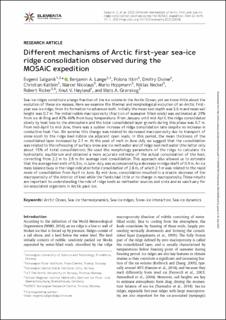| dc.contributor.author | Salganik, Evgenii | |
| dc.contributor.author | Lange, Benjamin | |
| dc.contributor.author | Itkin, Polona | |
| dc.contributor.author | Divine, Dmitry | |
| dc.contributor.author | Katlein, Christian | |
| dc.contributor.author | Nicolaus, Marcel | |
| dc.contributor.author | Hoppmann, Mario | |
| dc.contributor.author | Neckel, Niklas | |
| dc.contributor.author | Ricker, Robert | |
| dc.contributor.author | Høyland, Knut Vilhelm | |
| dc.contributor.author | Granskog, Mats | |
| dc.date.accessioned | 2023-07-06T08:13:25Z | |
| dc.date.available | 2023-07-06T08:13:25Z | |
| dc.date.created | 2023-06-23T14:35:47Z | |
| dc.date.issued | 2023 | |
| dc.identifier.issn | 2325-1026 | |
| dc.identifier.uri | https://hdl.handle.net/11250/3076480 | |
| dc.description.abstract | Sea-ice ridges constitute a large fraction of the ice volume in the Arctic Ocean, yet we know little about the evolution of these ice masses. Here we examine the thermal and morphological evolution of an Arctic first-year sea-ice ridge, from its formation to advanced melt. Initially the mean keel depth was 5.6 m and mean sail height was 0.7 m. The initial rubble macroporosity (fraction of seawater filled voids) was estimated at 29% from ice drilling and 43%–46% from buoy temperature. From January until mid-April, the ridge consolidated slowly by heat loss to the atmosphere and the total consolidated layer growth during this phase was 0.7 m. From mid-April to mid-June, there was a sudden increase of ridge consolidation rate despite no increase in conductive heat flux. We surmise this change was related to decreased macroporosity due to transport of snow-slush to the ridge keel rubble via adjacent open leads. In this period, the mean thickness of the consolidated layer increased by 2.1 m. At the peak of melt in June–July we suggest that the consolidation was related to the refreezing of surface snow and ice meltwater and of ridge keel meltwater (the latter only about 15% of total consolidation). We used the morphology parameters of the ridge to calculate its hydrostatic equilibrium and obtained a more accurate estimate of the actual consolidation of the keel, correcting from 2.2 m to 2.8 m for average keel consolidation. This approach also allowed us to estimate that the average keel melt of 0.3 m, in June–July, was accompanied by a decrease in ridge draft of 0.9 m. An ice mass balance buoy in the ridge indicated total consolidation of 2.8 m, of which 2.1 m was related to the rapid mode of consolidation from April to June. By mid-June, consolidation resulted in a drastic decrease of the macroporosity of the interior of keel while the flanks had little or no change in macroporosity. These results are important to understanding the role of ridge keels as meltwater sources and sinks and as sanctuary for ice-associated organisms in Arctic pack ice. | en_US |
| dc.language.iso | eng | en_US |
| dc.publisher | University of California Press | en_US |
| dc.rights | Navngivelse 4.0 Internasjonal | * |
| dc.rights.uri | http://creativecommons.org/licenses/by/4.0/deed.no | * |
| dc.subject | Sjøis | en_US |
| dc.subject | Sea ice | en_US |
| dc.subject | Arktis | en_US |
| dc.subject | Arctic | en_US |
| dc.subject | Polhavet | en_US |
| dc.subject | Arctic ocean | en_US |
| dc.title | Different mechanisms of Arctic first-year sea-ice ridge consolidation observed during the MOSAiC expedition | en_US |
| dc.title.alternative | Different mechanisms of Arctic first-year sea-ice ridge consolidation observed during the MOSAiC expedition | en_US |
| dc.type | Peer reviewed | en_US |
| dc.type | Journal article | en_US |
| dc.description.version | publishedVersion | en_US |
| dc.subject.nsi | VDP::Andre geofag: 469 | en_US |
| dc.subject.nsi | VDP::Other geosciences: 469 | en_US |
| dc.source.volume | 11 | en_US |
| dc.source.journal | Elementa: Science of the Anthropocene | en_US |
| dc.source.issue | 1 | en_US |
| dc.identifier.doi | 10.1525/elementa.2023.00008 | |
| dc.identifier.cristin | 2157529 | |
| cristin.ispublished | true | |
| cristin.fulltext | original | |
| cristin.qualitycode | 1 | |

